ORIF - Hook plate
1. Introduction
Clavicle hook plate fixation is indicated when there is insufficient bone in the distal clavicular fragment for adequate fixation with a conventional or distal clavicle plate.
The decision to proceed with hook plate fixation can be made preoperatively or intraoperatively if unanticipated inadequate fixation is obtained in the distal fragment.
This makes hook plate fixation an attractive alternative when unexpected difficulties are encountered with fixation of the distal clavicular fragment.
One drawback of hook plate fixation is that, following solid healing of the fracture, plate removal is generally required to optimize shoulder range of motion and eliminate residual discomfort from the hardware.
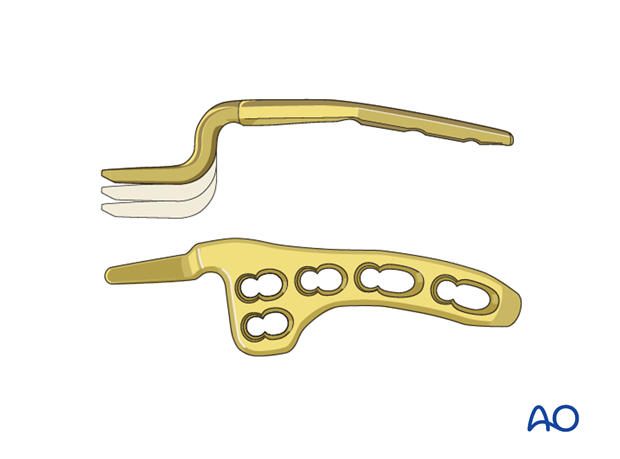
AO teaching video: Lateral Clavicle—Dislocations and Fractures—The LCP Clavicle Hook Plate
2. Patient preparation and approach
Patient preparation
This procedure is normally performed with the patient either in a beach chair or a supine position.
Approach
For this procedure a superior approach is normally used.
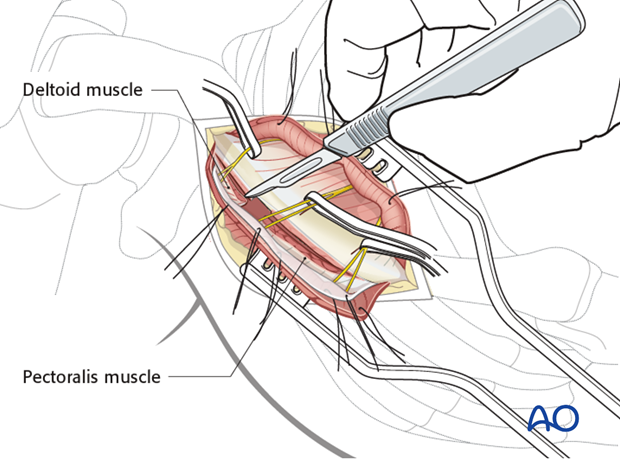
3. Verification of necessity of hook plate use
Following reflection of the deltoid the distal clavicle fracture site is identified and cleared of any hematoma or debris.
Pitfall: it important to preserve the integrity of the acromioclavicular joint capsule, as this contributes to stability of the small distal clavicular fragment.
A sterile 18-gauge needle is used to identify the acromioclavicular joint (this allows the surgeon a clear determination of the size and integrity of the distal clavicular fragment). Assessment is then performed whether conventional plate fixation is possible, or if hook plate use is required.
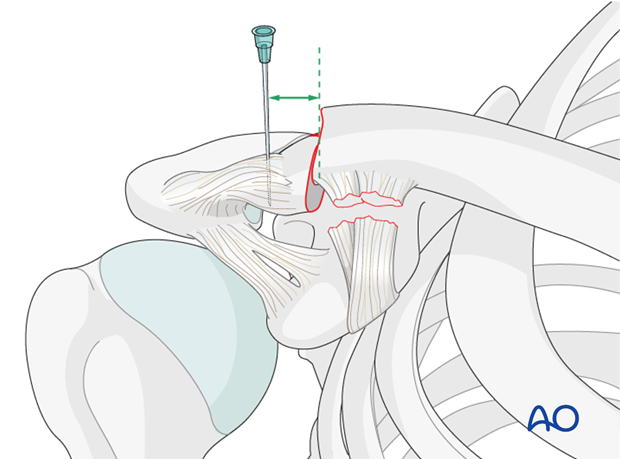
4. Direct reduction and fixation
Reduction
Reduction can be performed with several different methods, depending on fracture configuration and surgeon’s preference. Generally, reduction will be easier if the shoulder girdle is supported and prevented from sagging downwards.
Conventional direct reduction can be performed using fracture clamps on the proximal and distal fragments, with downward and anterior pressure on the proximal fragment and superior force on the distal fragment and attached shoulder girdle.
Alternatively, a ball-spiked pusher may be utilized to align the fragments.
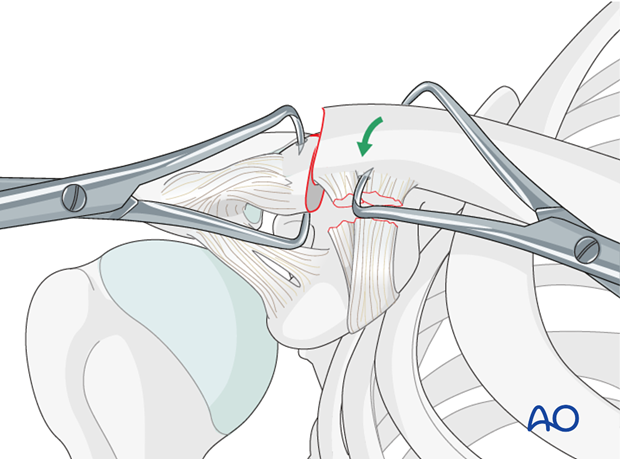
Temporary fixation
Following accurate reduction, temporary fixation with a K-wire directed from anterior to posterior can be performed.
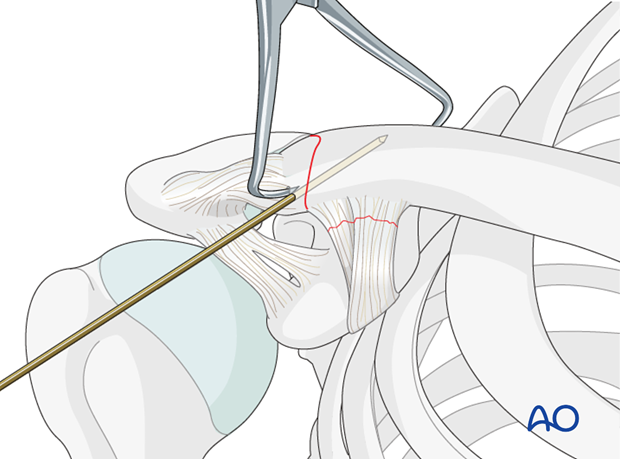
Alternatively (and preferentially), if fracture configuration permits, a lag screw can be placed at this point.

Incision for hook placement
A small incision is made at the posterior aspect of the acromioclavicular joint to allow sub-acromial placement of the hook.
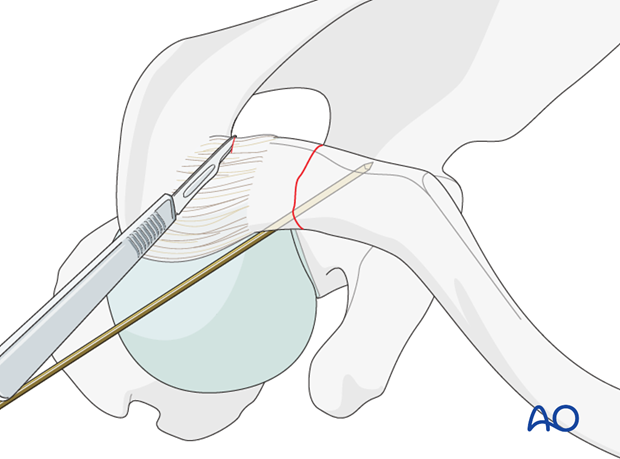
Plate selection
The trial hook plates are used to select the correct length of plate (to allow a minimum of 3 screws in the proximal fragment) and to determine the correct depth of the hook.
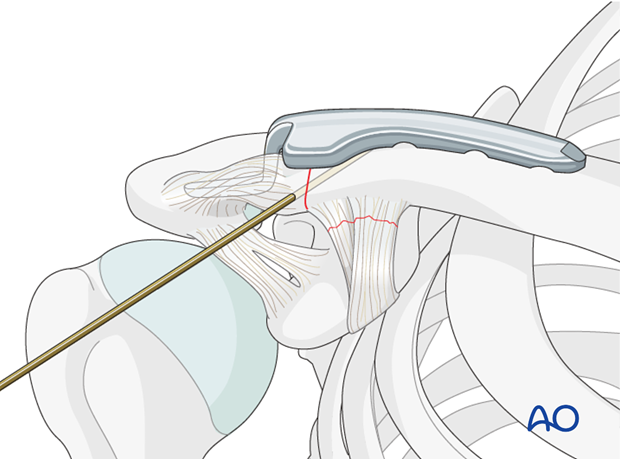
Plate positioning
At this point, the definitive hook plate is applied to the fracture.
Correct placement of the hook portion posteriorly under the acromion aids in reduction and avoids rotator cuff impingement.
The hook portion of the plate resists downward and medial translation of the arm through its tip position under the acromion.
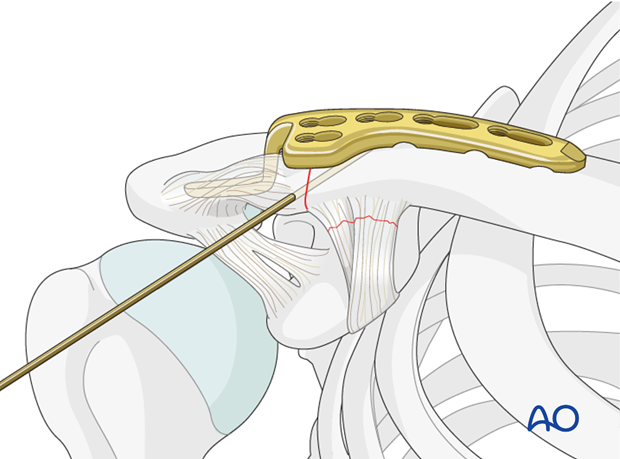
Plate application
The fixation of the hook plate is completed with insertion of the cortical screws in the shaft fragment and cancellous screws in the distal fragment to augment fixation.
Locking screws may be used if bone quality is poor.
The K-wire is removed.
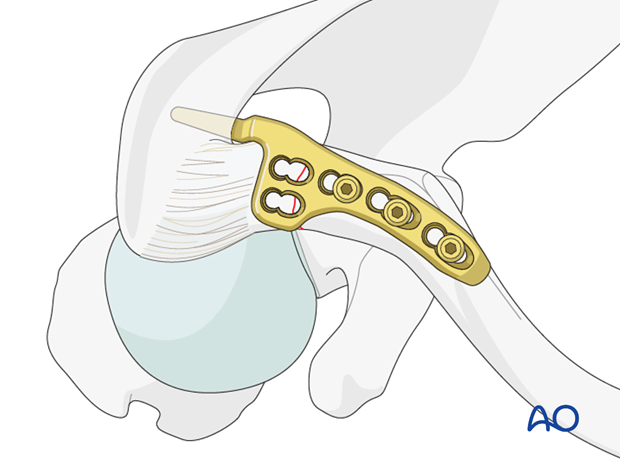
5. Indirect reduction and fixation
The hook plate is a powerful tool that can be used to provide an indirect reduction of a distal clavicle fracture.
This indirect reduction technique is useful for comminuted fractures or fractures with very small distal fragments in which conventional reduction and fixation is difficult.
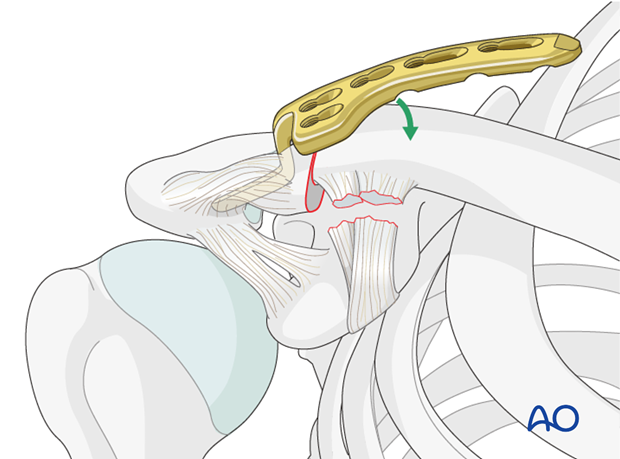
Incision for hook placement
A small incision is made on the posterior aspect of the acromioclavicular joint to allow subacromial hook placement.

Plate selection
With the hook portion of the trial hook plate in the subacromial space, the shaft portion of the hook plate is used to lever the shaft fragment in to place.

At this point a trial and error method with the three different trial hook plates depths is used to determine the optimal hook depth for accurate fracture reduction.
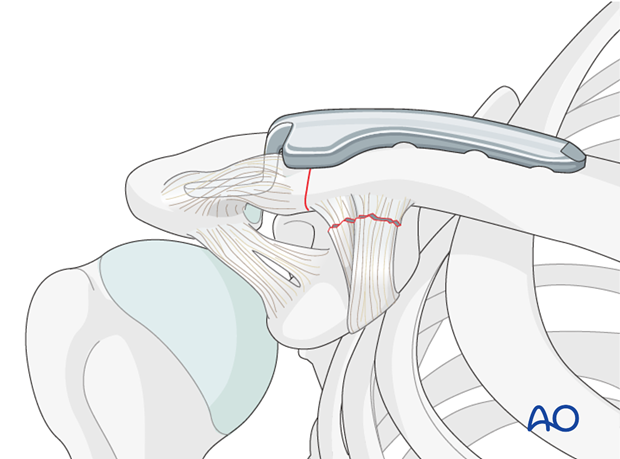
Pitfalls and pearls
Pitfall: It is important not to over-reduce the clavicle. This is the most common technical error and occurs when the hook depth chosen is too small which leads to inferior displacement of the shaft fragment. This results in an excessive pressure exerted on the acromion by the hook portion of the plate: acromial erosion or fracture can occur.
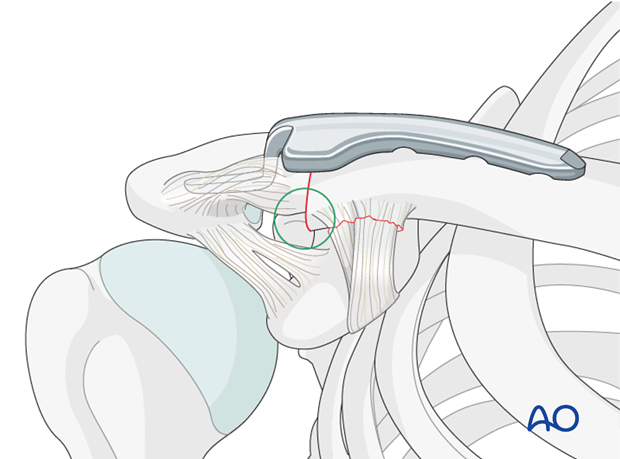
There are a number of intraoperative maneuvers that will help avoid over-reduction. These include:
- Selecting a hook depth that is appropriate for the individual case
- It may be necessary to contour the shaft or hook portion of the plate with the hand held bending irons to optimize plate placement, as anatomy in this area may be quite variable. Care should be taken not to bend he plate or hook repeatedly as this might lead to material failure
- Excessive downward pressure on the clavicle should be avoided as this often results in over-reduction
- A superior bony prominence of the distal clavicle may be resected to provide a flat superior surface for plate placement: this will prevent over-reduction of the clavicle
- In cases where reduction is uncertain, intraoperative imaging with a trial in place will clarify the degree of clavicular reduction and can aid in correction of any over-reduction

Pitfall: A too great hook depth will result in under-reduction, or residual superior displacement of the shaft fragment.

Pearl: It may be necessary to contour the shaft or hook portion of the plate with the hand held bending irons to optimize plate placement, as anatomy in this area may be quite variable. Care should be taken not to bend the plate or hook repeatedly as this might lead to material failure.
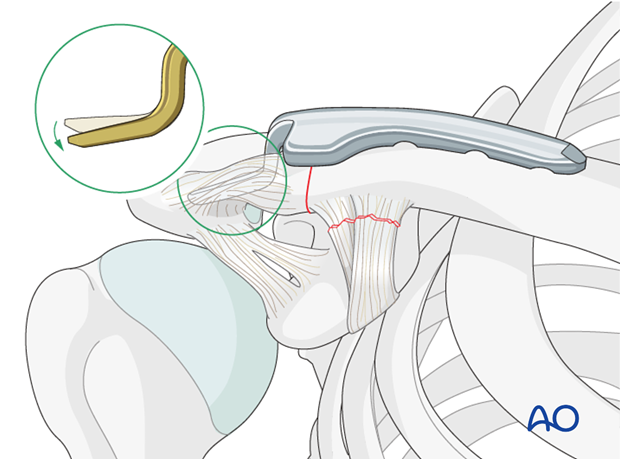
Hook placement
At this point, the definitive hook plate is applied to the fracture.
Correct placement of the hook portion posteriorly under the acromion aids in reduction and avoids rotator cuff impingement.
The hook portion of the plate resists downward displacement of the arm through its position under the acromion.
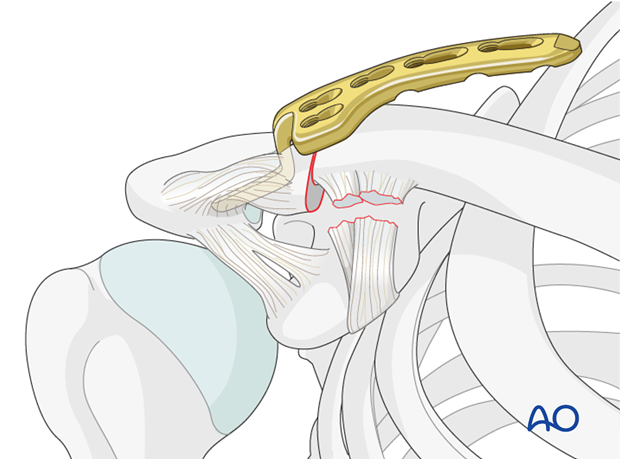
Reduction and plate application
To avoid excessive stress on any screw, insert first the screw closest to the fracture and tighten until appropriate resistance is felt. This may leave the plate proud but...

…sequential insertion of the following screws should approximate it to the shaft fragment and result in accurate fracture reduction. Note this can be done only if regular screws are used. Locking screws are contraindicated for such a maneuver.
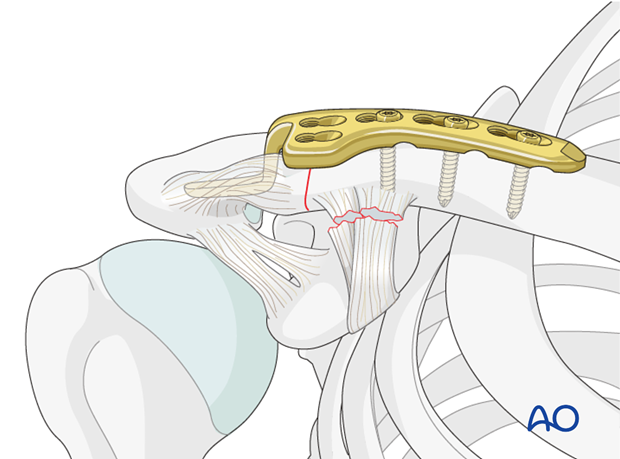
If feasible, the coracoclavicular ligaments should be repaired with sutures.
Alternative techniques for ligament repair can be found here:
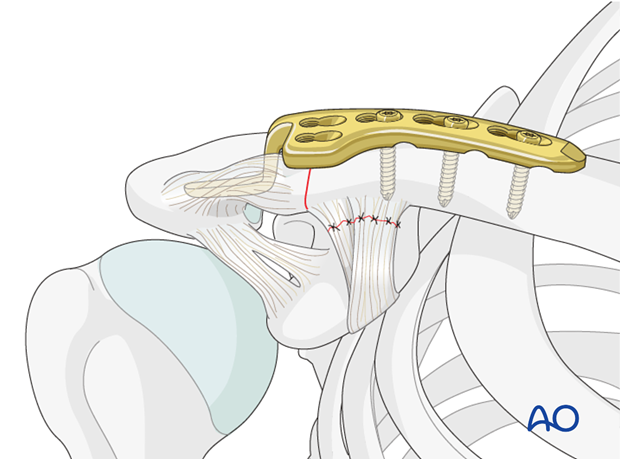
6. Check of osteosynthesis
At the conclusion of fixation, the fracture site, plate and screws are carefully checked to ascertain accurate reduction, correct plate placement, and avoidance of any intra-articular screw placement. If any doubt remains regarding these findings, an intraoperative radiograph should be taken for confirmation.
7. Aftercare
The aftercare can be divided into 4 phases:
- Inflammatory phase (week 1–3)
- Early repair phase (week 4–6)
- Late repair and early tissue remodeling phase (week 7–12)
- Remodeling and reintegration phase (week 13 onwards)
Full details on each phase can be found here.













